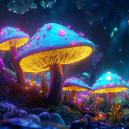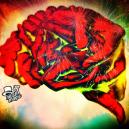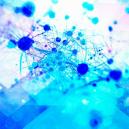The Difference Between Psilocybin & Psilocin
Published :
September 25th, 2017
Categories :
Research

Psilocybin and psilocin are two sides of the same coin. They always coexist in magic mushrooms with psilocybin being predominant and more stable. They are similar chemically, with psilocin being the psychoactive compound that stimulates the human brain. Both compounds are tryptamines and are very similar in chemical composition to serotonin.
Psilocybin and psilocin are two sides of the same coin. They always coexist in magic mushrooms with psilocybin being predominant and more stable. They are similar chemically, with psilocin being the psychoactive compound that stimulates the human brain. Both compounds are tryptamines and are very similar in chemical composition to serotonin.
Psilocin oxidises and loses its potency very quickly. This can be observed in the blue, black or purple bruising that occurs when mushrooms are picked. Psilocybin has an added phosphorous chain in its makeup which prevents oxidisation. This is why psilocybin-containing mushrooms can be dried and kept for a long time without a drop in potency. In fact, dried psilocybin mushrooms become more potent when dehydrated. This stability is also the reason that psilocybin and not psilocin is synthesised in the lab for research.
THE CHEMISTRY
Serotonin or 5-Hydroxytryptamine (5-HT) is a biochemical messenger and regulator synthesised from the essential amino acid L-Tryptophan. Psilocin or 4-hydroxy N,N dimethyltryptamine (4-HO-DMT) is an agonist to the serotonin receptors in the brain. Psilocybin or O-phosphoryl-4-hydroxy N,N dimethyltryptamine needs to be processed by the liver to remove the phosphorous chain (dephosphorylation) before becoming the psychoactive compound psilocin. Because they do not affect the dopamine system, tryptamines are not addictive.
Both compounds also resemble N,N dimethyltryptamine or DMT, the active ingredient in ayahuasca. Similarly, the secretions from Bufo alvarius, Bufo bufo marinus toads, and Phyllurus grass contain 5-MeO-DMT which, when combined with an MAOI (monoamine oxidase inhibitor), can induce sustained hallucinatory experiences.
POTENCY
Psilocin trips last for about 5-8 hours, with the primary effects being visual and eschatological. Colours appear more vivid, surroundings can take on haloes and there is a general sense of well-being. In comparison, LSD is 1000 times stronger and can last from 8-12 hours. Although much more potent, the dose is relative and the experiences could be considered similar in intensity. Typically, a psilocybin dose is up to 50 milligrams (50,000 micrograms) whereas a typical LSD dose is 50 micrograms.
BRIEF HISTORY
Magic mushrooms were ushered into modern consciousness by R Gordon Wasson in 1957 via his Life article "Seeking the Magic Mushroom." The following eight years saw the synthesising and naming of psilocybin and psilocin by Dr. Albert Hofmann of LSD fame. The establishment of these compounds, followed two years later by the disbanding of the Harvard Psilocybin Project eventually resulted in the complete prohibition of both substances by 1965, after which all research and therapy came to a halt.
MEDICINE OF THE FUTURE
Psilocybin is now experiencing a renaissance. Recent studies have shown psilocybin and psilocin may act as primary medicines in the treatment of a number of mental disorders. A single dose combined with clinical therapy has been shown to banish end of life crises for the terminally ill. Test subjects showed improved psychological, spiritual, and existential well being. Patients experienced a deeply felt and sustained positive mood that lasted for at least six months post-trial.






















